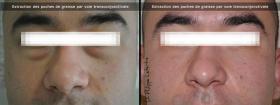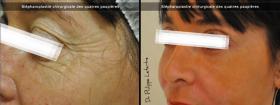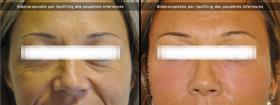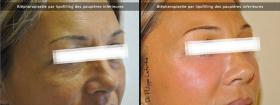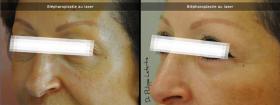Eyelid cosmetic surgery rejuvenate gaze blepharoplasty
What are the motivations for a Blepharoplasty ?
Our eyelids undergo unsightly changes over time that make us more tired, sad or older.
- The signs of aging are felt usually on 3 levels :
- Heavy and drooping upper eyelids
- Droopy and wilted lower eyelids
- Fat hernias responsible for "under-eye puffiness" or "puffy" upper eyelids.
What are the objectives of cosmetic surgery ?
It aims to correct durably unpleasant gaze and restore the luminous aspect of your face.
The surgeon corrects the eyelids excess skin and fat hernias without affecting the essential functions of the eyelids.
A Blepharoplasty can be carried out in isolation or in combination with one or more other surgeries or face beauty treatments to rejuvenate your face in the best possible way. This will be the subject of a consultation between you and your surgeon.
Eyelid surgery has made great progress in recent years.
What happens during the surgery ?
The surgeon makes an incision that varies depending on the area to be corrected to remove the herniated fat, the drooping sagging muscle and skin.
Then refinement techniques can be made to beautify the final result.
+ What is the type of anesthesia ?
According to the case, anesthesia may be local, deep if administered intravenously by tranquilizers or general.
This will be the subject of a discussion between you and your surgeon during a consultation.
+ Where is located the incision ?
- For the intervention of the upper eyelid : they are hidden in a natural fold (upper palpebral fold).
- For the intervention of the lower eyelid : they are placed at 1 or 2 mm below the eyelashes.
- For fat hernias without excess skin to be removed : they are placed inside the lower eyelid, leaving no visible scar on the skin.
+ And the scar ?
So It is hidden in natural folds and sometimes invisible.
+ How long is the surgery ?
The length of the procedure varies between 1 and 2 hours.
What are the postoperative courses ?
Hospitalization usually lasts a day or takes place on an out-patient basis.
The postoperative course is almost painless, but some discomfort on the eyelids, possibly with a mild eye irritation or visual disturbances may be felt sometimes.
Bruising (bruises), an edema (swelling) and watery eyes appear on the treated area, but gradually disappear.
The first day, you have to rest up as much as possible and avoid any violent effort.
Threads are removed between the fourth and sixth day after surgery, allowing a gradual return to normal activities.
Light pink colored scars on first weeks may be covered up with make-up after approximately one week.
What is the expected result ?
Your face has found back a luminous aspect, your gaze no longer looks old, tired and sad. Removal of the "under-eye puffiness" is almost permanent, and these do not usually recur.
You must wait 3 to 6 months to evaluate the final result, so that the tissues have regained their flexibility and the scars have faded.
The results of blepharoplasty are considered among the most durable plastic surgeries.
There is never a sudden recurrence and aging retakes a normal course.
What are the possible complications ?
Following any operation whatsoever , certain complications can occur, the first ones related to the medical activity and the others to anesthesia.
Although possible complications only represent a small percentage, it is necessary to know them.
+ What are the specific risks of anesthesia ?
During your obligatory talk with the anesthetist, he will inform you in detail of the risks of anesthesia.
It is useful to know besides that during the last twenty years, the risks have not been eradicated but remain almost insignificant.
+ What are the specific risks of the surgery ?
During the consultations with your surgeon all the possible complications will be detailed to you . Fortunately the real complications are rare.
- To inform you in advance, here are the possible risks :
- An hematoma : requiring evacuation.
- An infection : which may require antibiotic treatment.
- Ptosis (difficulty to fully open the upper eyelid) : sometimes happens beyond 70 years old when a prior deficit can eventually be increased by the intervention.
- Lagophthalmos (inability to completely close the upper eyelid) : possible the first few days after surgery but not beyond.
These informations given by Dr. Philippe Letertre should only be a help or a supplement to your surgeon’s consultations
Our space "Questions / Answers" is also available for you.
Feel free to contact Dr. Letertre
so that he could meet your expectations.


